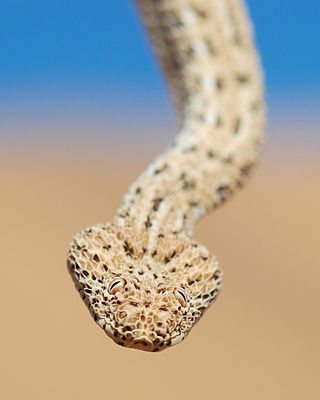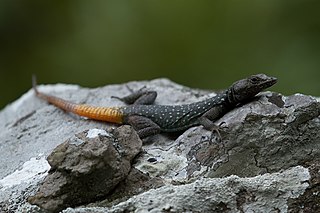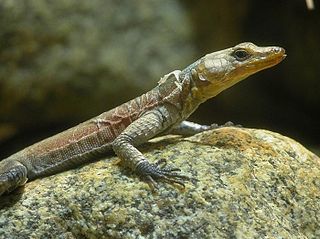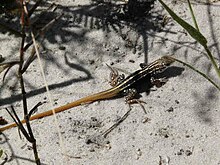
Heliobolus is a genus of lizards of the family Lacertidae. The genus is endemic to Africa.

Ground beetles are a large, cosmopolitan family of beetles, the Carabidae, with more than 40,000 species worldwide, around 2,000 of which are found in North America and 2,700 in Europe. As of 2015, it is one of the 10 most species-rich animal families. They belong to the Adephaga. Members of the family are primarily carnivorous, but some members are herbivorous or omnivorous.

The arboreal salamander is a species of climbing salamander. An insectivore, it is native to California and Baja California, where it is primarily associated with oak and sycamore woodlands, and thick chaparral.

Anthia is a genus of the ground beetle family (Carabidae) from Africa and Asia. Species of Anthia can spray a jet of formic acid up to 30 centimetres (12 in), which, if not treated, can cause blindness in animals that harass the beetles.

Chondrodactylus bibronii, commonly known as Bibron's thick-toed gecko, Bibron's sand gecko, or simply Bibron's gecko, is a species of lizard in the family Gekkonidae. The species is native to southern Africa. C. bibronii has been used as an animal model in bioastronautic research examining the effects of spaceflight on the morphology and physiology of vertebrates.

Bitis peringueyi, also known as the Peringuey's adder, Peringuey's desert adder or desert sidewinding adder, is a venomous viper species found in Namibia and southern Angola. No subspecies are currently recognized.

Platysaurus broadleyi, also known commonly as the Augrabies flat lizard and Broadley's flat lizard, is a species of lizard in the family Cordylidae. The species is endemic to South Africa.
The dwarf flat lizard or lesser flat lizard is a lizard in the family Cordylidae. It is found in Southern Africa.

The Lebombo flat lizard is a species of lizard in the family Cordylidae.
The orange-throated flat lizard is a species of lizard in the Cordylidae family.

The ocellated flat lizard or Chimanimani flat lizard is a species of lizard in the family Cordylidae. It is endemic to the Chimanimani Mountains of south eastern Zimbabwe and western Mozambique.

The Sekukhune flat lizard is a species of lizard in the family Cordylidae. The species is endemic to South Africa. It has two subspecies.

The Pungwe flat lizard is a species of lizard in the Cordylidae family.

The Mozambique girdled lizard or flame-bellied armadillo lizard is a large, flattened, girdled lizard found on Mount Gorongosa in Mozambique and low elevations in the Chimanimani Mountains at the border of Zimbabwe and Mozambique. It lives in rock outcrops in grasslands and dry, wooded mountain slopes.

Warren's girdled lizard is a species of relatively large, flattened lizard in the family Cordylidae. The species is native to Southern Africa.

Dumeril's monitor is a species of lizard in the family Varanidae. The species is endemic to Southeast Asia.

Pachydactylus atorquatus, also known commonly as the Augrabies gecko and Good's gecko, is a species of thick-toed gecko, a lizard in the family Gekkonidae. The species is native to southern Africa.

The black-necked agama is a species of tree agama that is native to East, Central and southern Africa. Its largest continuous range is in southeastern Africa, and it occurs at high densities in the Kruger National Park.
Heliobolus spekii, also known commonly as Speke's sand lizard, is a species of lizard in the family Lacertidae. The species is native to East Africa and the Horn of Africa. There are three recognized subspecies.

Pedioplanis namaquensis, known commonly as the Namaqua sand lizard or l'Érémias namaquois, is a species of lizard in the family Lacertidae. The species is endemic to Southern Africa.



















